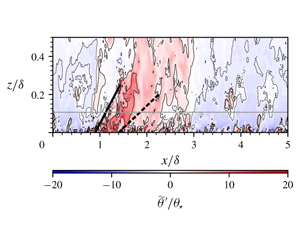Published online by Cambridge University Press: 17 December 2019

Observational and computational studies of inertia-dominated wall turbulence with unstable thermal stratification have demonstrated that the inclination angle of large-scale motions (LSMs) increases with increasing buoyancy (as characterized by the Monin–Obukhov stability variable  $\unicode[STIX]{x1D701}_{z}$). The physical implications of this structural steepening have received relatively less attention. Some authors have proposed that LSMs thicken – yet remain attached to the wall – with increasing buoyancy (Salesky & Anderson, J. Fluid Mech., vol. 856, 2018, pp. 135–168), while others have presented evidence that the upstream edge of an LSM remains anchored to the wall while its downstream edge lifts away from the wall (Hommema & Adrian, Boundary-Layer Meteorol., vol. 106, 2003, pp. 147–170). Using a suite of large-eddy simulations (LES) of unstably stratified turbulent channel flow, we demonstrate that buoyancy acts to lift LSMs away from the wall, leaving a wedge of fluid beneath with differing momentum. We develop a prognostic model for LSM inclination angle that accounts for this observed structure, where the LSM inclination angle
$\unicode[STIX]{x1D701}_{z}$). The physical implications of this structural steepening have received relatively less attention. Some authors have proposed that LSMs thicken – yet remain attached to the wall – with increasing buoyancy (Salesky & Anderson, J. Fluid Mech., vol. 856, 2018, pp. 135–168), while others have presented evidence that the upstream edge of an LSM remains anchored to the wall while its downstream edge lifts away from the wall (Hommema & Adrian, Boundary-Layer Meteorol., vol. 106, 2003, pp. 147–170). Using a suite of large-eddy simulations (LES) of unstably stratified turbulent channel flow, we demonstrate that buoyancy acts to lift LSMs away from the wall, leaving a wedge of fluid beneath with differing momentum. We develop a prognostic model for LSM inclination angle that accounts for this observed structure, where the LSM inclination angle  $\unicode[STIX]{x1D6FE}$ is the sum of the inclination angle observed in a neutrally stratified wall-bounded turbulent flow,
$\unicode[STIX]{x1D6FE}$ is the sum of the inclination angle observed in a neutrally stratified wall-bounded turbulent flow,  $\unicode[STIX]{x1D6FE}_{0}\approx 12^{\circ }{-}15^{\circ }$, and the stability-dependent inclination angle of the wedge
$\unicode[STIX]{x1D6FE}_{0}\approx 12^{\circ }{-}15^{\circ }$, and the stability-dependent inclination angle of the wedge  $\unicode[STIX]{x1D6FE}_{w}(\unicode[STIX]{x1D701}_{z})$. Reported values of
$\unicode[STIX]{x1D6FE}_{w}(\unicode[STIX]{x1D701}_{z})$. Reported values of  $\unicode[STIX]{x1D6FE}(\unicode[STIX]{x1D701}_{z})$ from the literature, LES results and atmospheric surface layer observations are found to be in good agreement with the new model for
$\unicode[STIX]{x1D6FE}(\unicode[STIX]{x1D701}_{z})$ from the literature, LES results and atmospheric surface layer observations are found to be in good agreement with the new model for  $\unicode[STIX]{x1D6FE}(\unicode[STIX]{x1D701}_{z})$.
$\unicode[STIX]{x1D6FE}(\unicode[STIX]{x1D701}_{z})$.